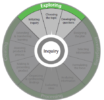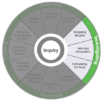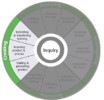 Exploring Exploring
(“Pre-Search”) |
- Initiate the inquiry by choosing an appropriate and personally engaging topic, and developing deep questions around the topic chosen.
|
- Define the task (Is the product and essay, presentation, website, infographic… etc.)
- Recall and make connections between prior knowledge of topic and current task.
- Explore topic by reading general sources such as encyclopedias, etc..
- Generate keywords and search terms for research
- Focus in on a specific question (working hypothesis)
- Identify most appropriate tools to record information, ideas and sources
- Share thinking with peers and teachers
|
|
 Investigating Investigating
(Research) |
- Investigate the topic by designing a plan of inquiry, finding appropriate sources, selecting relevant information, and formulating a clear and interesting focus.
|
- Locate a variety of resources appropriate to the inquiry.
- Assess quality, reliability and relevance of sources
- Select general and specific information appropriate to inquiry question / focus
- Use effective note-taking techniques
- Accurately record citation information and generate a list of sources
|
|
 Processing Processing
(Analyze) |
- Analyze the information they have found, evaluating ideas drawn from research, forming own ideas, then organizing and synthesizing findings.
|
- Compare and sort information in notes to identify patterns, characteristics, and relationships
- Think about findings and test working hypothesis / inquiry question
- Describe findings in conference with teacher
- Revise hypothesis / inquiry question if necessary (do findings support proposed question / thesis or do they require a change?
- Organize a plan / outline for the product and choose an appropriate format
|
|
 Creating Creating
(Share & Reflect) |
- Create a product that presents the results of the inquiry in a format appropriate for the subject and audience. Self and peer assessment of product and process. Transfer of learning to new contexts and inquiries.
|
- Generate properly formatted draft that includes correct documentation
- Consult with peer and/or teacher
- Revise and refine draft
- Proofread final product for grammar / spelling
- Share / submit final product
- Reflect on learning by completing a self-reflection conference / document / exit slip (Learning Skills Indicator)
|
- Demonstrate learning using various mediums/tools such as text, video, audio, graphics/infographics, programming, robotics, and makerspaces
- Option to use Google Originality Reports as a check against plagiarism in the first draft
- Rubrics to establish criteria for analyzing, evaluating, organizing, and synthesizing information and ideas
- Proofread: The Importance of Proofreading (YouTube video)
|

 Exploring
Exploring Investigating
Investigating Processing
Processing Creating
Creating
